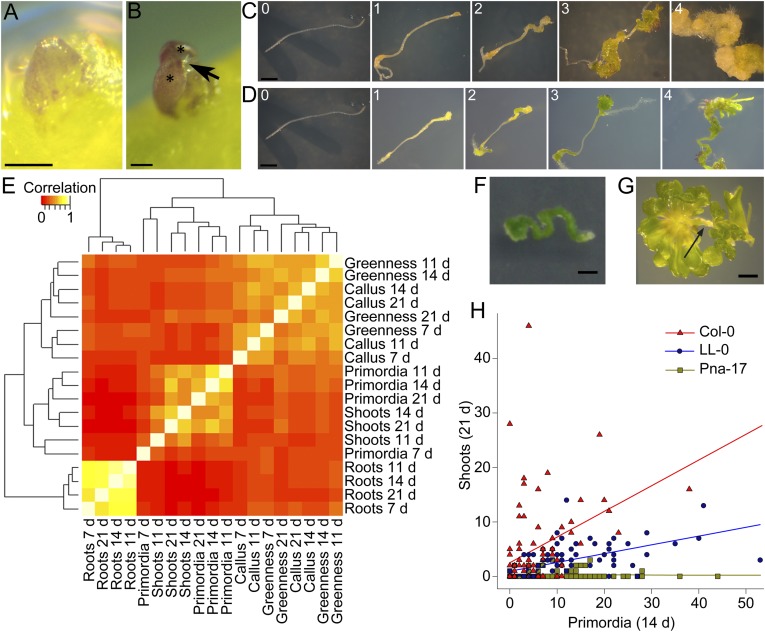Fig. 2.
Shoot, primordium, root, and callus formation and greening during the regeneration process and correlation between these different responses in 88 Arabidopsis accessions. (A) Representative primordium: green or purple dome-shaped or spherical structure with a smooth surface and a cellular organization. (Scale bar: 100 µm.) (B) Representative shoot: structure originating from a primordium with two or more leaves (asterisks) emerging from one meristem; arrow indicates trichomes. (Scale bar: 100 µm.) (C) Classification of callus formation; class 0, no callus; class 1, callus present at explant ends; class 2, callus present and covering maximum one-third of the explant; class 3, abundant callus but not covering the whole explant; class 4, excessive callus covering the whole explant. (Scale bar: 1 mm.) (D) Evaluation of different classes of explant greenness excluding shoots: class 0, white explant; class 1, yellow explant; class 2, (partially) pale green explant; class 3, completely green explant; class 4, completely dark green explant. (Scale bar: 1 mm.) (E) Correlation of different responses accompanying shoot regeneration (number of shoots, number of primordia, number of lateral roots, callus, and greenness) at different time points (7, 11, 14, and 21 d) of SIM incubation. The heat map represents the Spearman’s rank correlation matrix for the various responses; the dendrograms are distance trees. The experiment was done in triplicate with 30 explants per accession per repeat. Because almost no shoots were observed after 7 d of SIM incubation, this information was not included. (F) The more recalcitrant accession Eden-1 forming dark green callus without shoots. The picture was taken after 21 d of SIM incubation. (Scale bar: 1 mm.) (G) The regeneration-competent Wei-0 developing little callus, with a pale remaining explant and the formation of a lot of shoots. The picture was taken after 14 d of SIM incubation. The arrow marks the root explant. (Scale bar: 1 mm.) (H) Scatter plot of the number of primordia on an explant after 14 d plotted against the number of shoots on the same explant after 21 d of SIM incubation measured in 90 explants of the accessions Col-0, LL-0, and Pna-17. A linear regression was fitted to each accession: the more recalcitrant accession Pna-17 forms a lot of primordia but few shoots compared with Col-0, which has a high primordia-to-shoot development rate, and LL-0, which has an intermediate relation.

